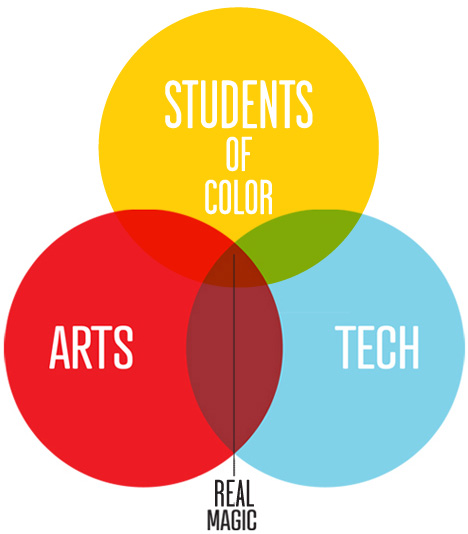
May
STEM to STEAM | Where Students of Color Fit Into the New Acronym
[responsivevoice_button voice=”UK English Female” buttontext=”Listen to Post”]
As a kid, I loved to draw. I would spend hours in my room drawing — losing sleep and not eating — just to draw. But I also loved to read history and watch the evening news. I was interested in physics, psychology, and sociology. I obsessed about finding patterns and ways to re-organize something to make it more visually appealing. But I had no idea how to put all these interests together in one career.
Who becomes a graphic designer?
I wasn’t exposed to graphic design in school until I was 12 years old. Even then, I struggled to see a career in the field beyond door hangers and logos. It wasn’t until I studied graphic design in college that I saw the full potential of design. It isn’t just about the application of fonts and colors; to be a graphic designer is to be a problem-solver of visual communications. It requires critical thinking, math, and engineering — and now more K-12 schools are catching on, too.
Spearheaded by The Rhode Island School of Design (one of America’s top design schools), more educators are embracing STEAM — Science, Technology, Art, Engineering, and Math — as a means of integrating arts and science-based education. Even Nancy Pelosi (D-CA) mentioned STEAM in her remarks on the Congressional floor. The arts provide a hands-on way to apply the concepts learned in more technical areas. “In my classes, students are engaged in learning challenging concepts, such as economic and political systems, through the lens of visual arts, music, and dance,” says DeMarcus Lewis, a teacher in a high-poverty middle school in Maryland, where educators incorporate the arts in social studies and math.
As more educators turn their attention toward STEAM, it’s important that they also ensure equitable access to these opportunities. A study in California has already noted opportunity gaps between students of color and their white peers when it comes to STEM subjects. Contrary to what some may think, STEAM instructions don’t have to be limited to affluent, well-resourced schools.
Drew Charter School, a low-income, predominantly African American school in Atlanta, was an early adopter of integrating arts into its curriculum. Teachers there focus on building knowledge through hands-on projects and activities that force students to look through the lens of an artist. Take the campus art installation piece as an example: What initially appears to be an abstract art piece is actually a fully functioning musical instrument conceived and created by students with the help of local musicians and engineers. Drew Charter understood STEAM before it was cool.
Students with a creative mind need more integration like this to see the connection, for example, between an algebraic equation and a visual identity system as a kit of parts. Integrating the arts is not merely drawing pretty pictures or making logos; it’s challenging students to see technical subjects through various forms of visual communication. And they all can be better for it.
Partial image courtesy of RISD’s STEM to STEAM Initiative


